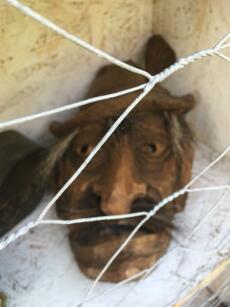The plague mask. On Death in Venice once more
By literary scholar Martina Wagner-Egelhaaf (German studies)

Why does the very obligation to wear a mask cause such resistance among people? Because it is simply unpleasant? Because it causes our glasses to fog up? Or because the mask reminds us of something that we prefer to repress? Death, for example? First of all, the masks to be worn every day hide part of the face and restrict the possibility of reading the face of the person opposite. Like theatre masks or masks in carnival, where you do not know who is hidden behind the mask, masks seem to de-individualize the person.
It is worth taking a second look at Thomas Mann’s 1912 novella Death in Venice. In the passage already quoted in a previous dossier (https://www.uni-muenster.de/Religion-und-Politik/aktuelles/schwerpunkte/epidemien/01_thema_raum.html), it is said that the “spectre” of the epidemic shows “its mask” (67-68). But the protagonist Gustave Aschenbach also increasingly becomes a masked person. On his walk to the English Gardens in Munich described at the beginning of the story, which, interestingly enough, took place during a “mock summer” in May (see 3-4), Aschenbach encounters a strange apparition at the tram stop: his eye is caught by a thin, red-haired man with “milky, freckled skin” and a “distinctly exotic” appearance (4), “colourless, red-lashed eyes” and a “little turned-up nose” (5). The face seems to be marked by a physiognomic deformity: “his lips” seemed “to curl back”, laying bare “the long, white, glistening teeth to the gums” (5). Unable to stand the stranger’s aggressive gaze, the writer flees.
When he takes the ship from Pola to Venice, he meets another suspicious figure on board, an “apparent youth”:
He was an old man, beyond a doubt, with wrinkles and crow’s-feet round eyes and mouth; the dull carmine of the cheeks was rouge, the brown hair a wig. His neck was shrunken and sinewy, his turned-up moustaches and small imperial were dyed, and the unbroken double row of yellow teeth he showed when he laughed were but too obviously a cheapish false set. He wore a seal ring on each forefinger, but the hands were those of an old man. Aschenbach was moved to shudder as he watched the creature and his association with the rest of the group. (18)
Finally in Venice, one evening after dinner, a band of street musicians from the city performs in the hotel garden where Aschenbach is staying. One of the band, “who played the guitar”, was “a sort of baritone buffo” and was “possessed of a pantomimic gift” (62). He is described as follows:
He was a man of slight build, with a thin, undernourished face; his shabby felt hat rested on the back of his neck, a great mop of red hair sticking out in front … He wore a white sports shirt with a suit of ordinary clothes, and a strikingly large and naked-looking Adam’s apple rose out of the open collar. From that pale, snub-nosed face it was hard to judge of his age; vice sat on it, it was furrowed with grimacing, and two deep wrinkles of defiance and self-will, almost of desperation, stood oddly between the red brows, above the grinning mobile mouth … He glided between the tables, bowing and scraping, showing his strong white teeth in a servile smile … [At the gate,] he threw off his buffoon’s mask, stood erect, with an elastic straightening of his whole figure, ran out his tongue impudently at the guests on the terrace, and vanished in the night. (63-66)
When Aschenbach, the epidemic now determining life in the city, is mortified by the sight of his grey hair in the mirror, he visits the “hotel barber”, who assures Aschenbach that he has a right to his “natural colour” (73) and offers to restore it to him.
“How?” asked Aschenbach.
For answer the oily one washed his client’s hair in two waters, one clear and one dark, and lo, it was as black as in the days of his youth. He waved it with the tongs in wide, flat undulations, and stepped back to admire the effect.
“Now if we were just to freshen up the skin a little”, he said.
And with that he went on from one thing to another, his enthusiasm waxing with each new idea. Aschenbach ... watched [the process] in the mirror and saw his eyebrows grow more even and arching, the eyes gain in size and brilliance, by dint of a little application below the lids. A delicate carmine glowed on his cheeks where the skin had been so brown and leathery. The dry, anaemic lips grew full, they turned the colour of ripe strawberries, the lines round eyes and mouth were treated with a facial cream and gave place to youthful bloom. (74)

The end of the story is known: sitting in a deck chair on the beach, Aschenbach once again follows the sought-after boy Tadzio with his eyes. In Visconti’s film adaptation, we see how the make-up runs off Aschenbach’s face until his head “sank on his breast” (79). What makes Mann’s novella uncanny is that the grimace of death comes ever closer until it also appropriates the physiognomy of the protagonist, and mask and face become indistinguishable.
In contrast, the modern mask can be taken off when not (or no longer) needed – but only if it is worn in the first place …

